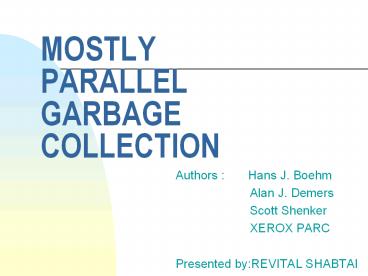MOSTLY PARALLEL GARBAGE COLLECTION PowerPoint PPT Presentation
1 / 24
Title: MOSTLY PARALLEL GARBAGE COLLECTION
1
MOSTLY PARALLEL GARBAGE COLLECTION
- Authors Hans J. Boehm
- Alan J. Demers
- Scott Shenker
- XEROX PARC
- Presented byREVITAL SHABTAI
2
Introduction
- A method for adapting garbage collectors designed
to run sequentially with the client.
3
Overview
- Problem introduction
- Basic idea
- Method components
- Implementation choices
- Empirical results
- Conclusions
4
Garbage Collectors Styles
- Two basic styles of garbage collection
algorithms 1.Reference-counting
collector 2.Tracing collector
5
Traditional Tracing
- A set of root memory objects -always accessible
- Mark - performing reachability from the roots
and marking the accessible objects - Sweep - reclaiming unmarked objects
6
The Problem
- A straightforward implementation prevents any
client action while tracing (stop-the-world) - Sometimes the tracing is an intolerable long
pause - Two approaches to reduce pause times of tracing
collectors 1.Generational collectors
2.Parallel collectors
7
The Basic Idea
- Most of the tracing algorithm runs in parallel
with the client - Small portion of the tracing is done during
stop-the-world action - Relying on virtual memory information about pages
that have been updates during a given period of
time
8
The Parallel Method
- Define a set of dirty bits for a set of virtual
pages - Clear all virtual dirty bits
- Perform a parallel tracing
- Update the dirty bits to reflect client writes
- Stop-the-world and trace from all marked objects
that lie on dirty pages - Reclaim unreachable (unmarked) objects
9
Method - Comments
- The parallel tracing phase provides an
approximation to the true reachable set - The stop-the-world tracing phase provides a full
complete set of the reachable objects - The duration of the final stop-the-world phase is
related to the number of pages written during the
parallel collection
10
Method -Comments 2
- Not all unreachable objects are reclaimed, but
will be reclaimed by a subsequent collection - Copying collectors (moving objects) require a
more careful treatment
11
The Mark Phase
- Split the heap into blocks
- In each block objects of the same size
- A block size is the a physical page
- Set a bit for each accessible object
- Queue pages for sweeping in a separate queue for
each object size
12
The Sweep Phase
- Done with object allocation (not during a
stop-the-world) - The allocator keeps a free lists for each object
size - If an empty free list is found
- Sweep the first page in the queue
- Remove the page from the queue
- Restore unreachable objects from this page to the
free list
13
Consequences
- Worst case of mark phase duration is as in the
non-parallel tracing - Worst case of allocating objects is when full
pages are scanned in order to find free
objects - In practice both are not noticeable
14
Partial Collector - Formal Definitions
- Partial Collector - a collector that reclaims
only a subset of all unreachable objects - A set T (threatened) - potentially collectible
objects - A set I (immune) - the non-collectible objects
15
Formal Statements
- C Every object in I is marked and every object
pointed to by a marked object is also marked - TR Mark all objects in I and trace from them
- F Trace from all marked objects on dirty pages
16
Stop the mostly world
parallel
- Stop the world
- Clear all mark bits
- Perform TR
- Restart the world
- Clear all mark bits
- Clear all virtual dirty bits
- Perform TR
- Stop the world
- Perform F
- Restart the world
Condition C holds
Condition C does not hold
C Every object in I is marked and every object
pointed to by a marked object on a clean page is
also marked
17
Reducing the stop-the-world Delay
- M - Atomically clear the virtual dirty bits from
the pages P, and trace from the marked objects on
the dirty pages of P. - A Partial Generational Mostly Parallel
Collection 1.Perform M on the heap 2.Stop
the world 3.Perform F 4.Restart the
world
18
Reducing the stop-the-world Delay- Version 2
- M 1.Atomically clear the dirty bits from
the pages P 2.For all marked objects
pointed to by marked objects on dirty pages of P
mark them and dirty the pages on which they
reside
19
Implementation Choices
- Repeated applications of M instead of a single
application of M - Run M more that once before a partial collection
- Further variants of M are possible (such as M
mark from other sets) - When to run a full collection? When to expand
the heap? - How to control the scheduling of the client
and collector threads
20
Empirical Results
21
Mostly Parallel Copying Collectors
- For each object, additional space is required for
forwarding links - The collector copies from from-space to to-space
and update the forwarding links
22
Mostly Parallel Copying Collector Implementation
- Additions to the copying collector 1.Clear the
forwarding links 2.Update dirty pages
bits 3.Update forwarding links - In the stop-the-world phase for any object O that
lie on dirty page 1.Copy any object O points
at 2.Update pointers in copies 3.Copy O and
update its fields
23
Conclusion
- Mostly parallel partial generational tracing
collector that run sequentially with the client - Various implementation choices for various cases
- Reduced the stop-the-world phase time duration
24
THE END

